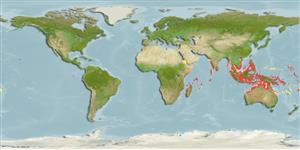Common names from other countries
>
Ovalentaria/misc (Various families in series Ovalentaria) >
Ambassidae (Asiatic glassfishes)
Etymology: Ambassis: Derived from Greek, anabasis = climbing up (Ref. 45335).
More on author: Bleeker.
Environment: milieu / climate zone / depth range / distribution range
Ecologie
marien; zoet water; brak water demersaal; amfidroom (Ref. 59012). Tropical; 19°N - 23°S
Asia: Indo-Australian Archipelago, including Indonesia, the Philippines, Borneo, Java, New Guinea, Vanuatu, New Caledonia, to northern Australia and the Andaman Sea. Reported from Palau (Ref. 6371) and the Ryukyu Islands (Ref. 559).
Lengte bij maturiteit / Grootte / Gewicht / Leeftijd
Maturity: Lm 7.0 range ? - ? cm
Max length : 12.0 cm TL mannelijk / geslacht onbekend; (Ref. 7050); common length : 5.0 cm SL mannelijk / geslacht onbekend; (Ref. 7242); max. gepubliceerd gewicht: 12.00 g (Ref. 7242)
Dorsale stekels (totaal): 8; Dorsale zachte stralen (totaal): 9-10; Anale stekels 3; Anale zachte stralen: 9 - 10. Body very high, 50% of SL. Lateral line incomplete, but a few pored scales on a silvery midlateral band. Lower margin of inter operculum with few spines. The second spine of the first dorsal fin is strong and very long.
Found in brackish-water, mangrove, estuarine and freshwater-stream habitats, usually within 20 km of the sea (Ref. 2847). They occur at temperatures ranging from 28 to 32°C. Found in schools and migrate to freshwater. Mainly diurnal. A predominantly marine or estuarine spawner. Caught by hand and scoop nets (Ref. 7242).
A nonobligatory plant spawner.
Allen, G.R., 1991. Field guide to the freshwater fishes of New Guinea. Publication, no. 9. 268 p. Christensen Research Institute, Madang, Papua New Guinea. (Ref. 2847)
Status op de Rode Lijst van het IUCN (Ref. 130435)
CITES (Ref. 128078)
Not Evaluated
Gevaar voor de mens
Harmless
Gebruik door de mens
Visserij: van minder commercieel belang
Meer informatie
ReferentiesAquacultuurAquacultuurprofielKweeklijnenGeneticaElectrophoresesErfelijkheidZiektesVerwerkingMassaconversie
Tools
Speciale rapporten
Download XML
Internetbronnen
Estimates based on models
Preferred temperature (Ref.
115969): 26.7 - 29.1, mean 28.4 (based on 1018 cells).
Fylogenetische diversiteitsindex (Ref.
82804): PD
50 = 0.5000 [Uniqueness, from 0.5 = low to 2.0 = high].
Bayesian length-weight: a=0.01175 (0.00677 - 0.02038), b=2.96 (2.81 - 3.11), in cm Total Length, based on LWR estimates for this species & Genus-body shape (Ref.
93245).
Trofisch niveau (Ref.
69278): 2.7 ±0.1 se; based on diet studies.
Weerstandsvermogen (Ref.
120179): Hoog, minimale populatieverdubbelingstijd minder dan 15 maanden (Fec=29,000-310,000).
Fishing Vulnerability (Ref.
59153): Low vulnerability (10 of 100).
